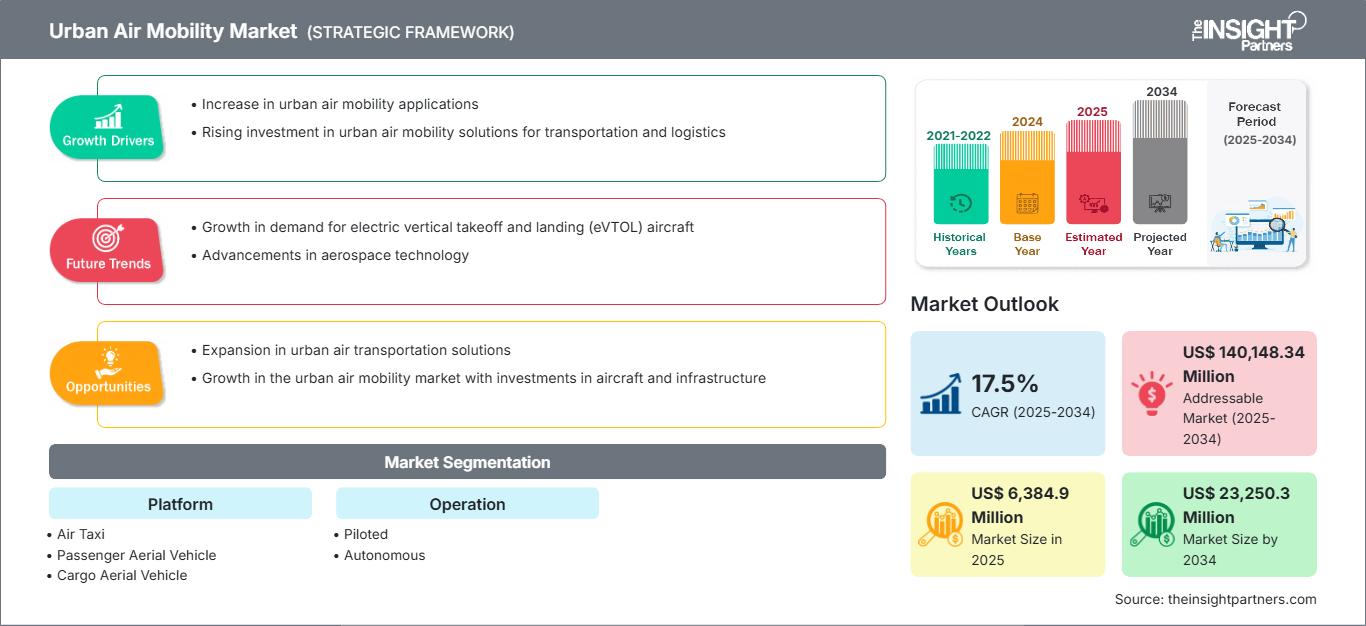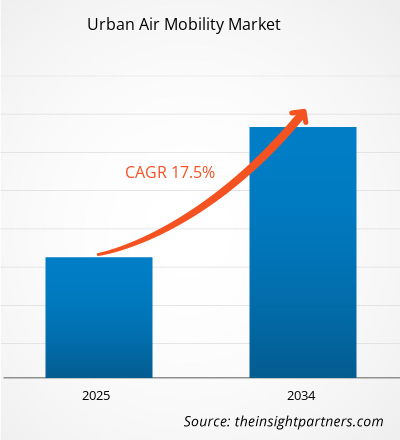Le marché de la mobilité aérienne urbaine devrait être évalué à 6 384,9 millions de dollars américains en 2025 et atteindre 23 250,3 millions de dollars américains d'ici 2034. Il devrait croître à un TCAC de 17,5 % au cours de la période de prévision de 2025 à 2034.
Un minimum de trois et un maximum de cinq à six passagers peuvent voyager à bord des transporteurs de passagers de mobilité aérienne urbaine. Dans les zones rurales, plus de six passagers voyagent à bord des transporteurs de passagers à trois roues, selon les besoins. L'augmentation des embouteillages dans les villes urbaines est un facteur majeur de la croissance du marché. Avec la croissance de la population urbaine mondiale, les embouteillages affectent gravement la qualité de vie des populations et pèsent sur la croissance économique générale. Par exemple, selon INRIX (un cabinet d'analyse du trafic), un navetteur américain passe environ 41 heures dans les embouteillages chaque année aux heures de pointe. Français Il a également mentionné que les embouteillages avaient coûté aux conducteurs américains environ 305 milliards de dollars américains en 2017, ce qui implique une moyenne de 1 445 dollars américains par conducteur. En outre, l'Agence américaine de protection de l'environnement a estimé qu'une voiture particulière émettait en moyenne 4,7 tonnes de dioxyde de carbone chaque année. De plus, les accidents de voiture ont augmenté, parallèlement à l'augmentation du nombre de véhicules dans les pays en développement comme l'Inde et la Chine. Selon l'Organisation mondiale de la santé (OMS), environ 1,25 million de personnes sont tuées dans des accidents de voiture chaque année, atteignant environ 3 400 décès par jour. Ce chiffre ne prend pas en compte les millions de blessés subis dans des accidents non mortels.
Le marché mondial de la mobilité aérienne urbaine est segmenté par type en transporteur de passagers et transporteur de marchandises. En fonction du type de carburant, le marché de la mobilité aérienne urbaine est segmenté en diesel, essence, GNC, GPL et électrique. La demande croissante de mobilité aérienne urbaine électrique, la croissance démographique et le besoin croissant d’un véhicule permettant de réduire les embouteillages dans la région ont stimulé la croissance du marché mondial de la mobilité aérienne urbaine.
Vous bénéficierez d’une personnalisation sur n’importe quel rapport - gratuitement - y compris des parties de ce rapport, ou une analyse au niveau du pays, un pack de données Excel, ainsi que de profiter d’offres exceptionnelles et de réductions pour les start-ups et les universités
Marché de la mobilité aérienne urbaine: Perspectives stratégiques

- Obtenez les principales tendances clés du marché de ce rapport.Cet échantillon GRATUIT comprendra une analyse de données, allant des tendances du marché aux estimations et prévisions.
Les avancées technologiques dans le domaine de l'aviation offrent la possibilité d'offrir un transport à la demande pratique et efficace pour les personnes et les marchandises dans les zones métropolitaines. La mobilité aérienne urbaine (MAU) est un concept de transport susceptible de reconstruire la mobilité sociétale. Elle propose un transport aérien urbain très abordable, accessible et rapide, qui réduirait la congestion au sol en déchargeant l'infrastructure de transport routière existante. La MU s'appuie sur les avancées technologiques telles que la propulsion électrique distribuée, les nouveaux modèles économiques comme le covoiturage basé sur des applications, et les tendances de la fabrication aérospatiale de pointe qui réduiront les coûts de production. Accroître la crédibilité de l'automatisation des véhicules et des opérations de véhicules autonomes sera essentiel pour concrétiser la vision de la MU autonome. L'autonomie sera nécessaire pour un système de transport économiquement viable, capable de répondre à la forte demande anticipée. L'augmentation significative de la maturité technologique des véhicules stables, manœuvrables, à décollage et atterrissage verticaux (VTOL) et du vol hautement automatisé va propulser l'industrie de l'UAM.
Analyse du marché basée sur les plateformes
Le marché de la mobilité aérienne urbaine se divise en taxis aériens, véhicules aériens de transport de passagers, véhicules aériens de transport de marchandises et ambulances aériennes. Un large éventail d'applications est disponible pour l'UAM, facilitant le transport simple et rapide de marchandises et de personnes. Ces UAM sont largement utilisés pour le transport de petits objets, de produits médicaux et de passagers. Cependant, ces solutions de mobilité ont leurs propres limites de vol en fonction de leur utilisation. Les véhicules UAM ne sont autorisés ni à voler à basse distance, car ils percuteraient des immeubles de taille moyenne ou élevée, ni à voler à haute distance, car ils percuteraient des compagnies aériennes.
Analyse du marché basée sur l'exploitation
Le marché de la mobilité aérienne urbaine se divise en véhicules pilotés et autonomes, selon leur exploitation. Le segment autonome devrait dominer le marché au cours de la période de prévision, car les eVTOL autonomes sont mieux adaptés au transport de marchandises et de passagers et devraient être de plus en plus utilisés pour le transport interurbain.
Les acteurs du marché de la mobilité aérienne urbaine se concentrent sur des stratégies telles que des initiatives commerciales, des acquisitions et des lancements de produits pour maintenir leur position sur ce marché. Voici quelques développements réalisés par les principaux acteurs du marché :
En février 2020, Airbus et l'Autorité de l'aviation civile de Singapour ont signé un protocole d'accord pour permettre la mobilité aérienne urbaine à Singapour. Cette collaboration permettrait de développer la mobilité aérienne urbaine dans le pays.
En février 2019, Airspace Experience Technologies a conclu un accord définitif avec Spirit AeroSystems pour la création d'avions 100 % électriques certifiés à décollage et atterrissage verticaux (eVTOL).
Aperçu régional du marché de la mobilité aérienne urbaine
Les tendances et facteurs régionaux influençant le marché de la mobilité aérienne urbaine tout au long de la période de prévision ont été détaillés par les analystes de The Insight Partners. Cette section aborde également les segments et la géographie du marché de la mobilité aérienne urbaine en Amérique du Nord, en Europe, en Asie-Pacifique, au Moyen-Orient et en Afrique, ainsi qu'en Amérique du Sud et en Amérique centrale.
Portée du rapport sur le marché de la mobilité aérienne urbaine
| Attribut de rapport | Détails |
|---|---|
| Taille du marché en 2025 | US$ 6,384.9 Million |
| Taille du marché par 2034 | US$ 23,250.3 Million |
| TCAC mondial (2025 - 2034) | 17.5% |
| Données historiques | 2021-2022 |
| Période de prévision | 2025-2034 |
| Segments couverts |
By Plateforme
|
| Régions et pays couverts | Amérique du Nord
|
| Leaders du marché et profils d'entreprises clés |
|
Densité des acteurs du marché de la mobilité aérienne urbaine : comprendre son impact sur la dynamique des entreprises
Le marché de la mobilité aérienne urbaine connaît une croissance rapide, portée par une demande croissante des utilisateurs finaux, due à des facteurs tels que l'évolution des préférences des consommateurs, les avancées technologiques et une meilleure connaissance des avantages du produit. Face à cette demande croissante, les entreprises élargissent leur offre, innovent pour répondre aux besoins des consommateurs et capitalisent sur les nouvelles tendances, ce qui alimente la croissance du marché.

- Obtenez le Marché de la mobilité aérienne urbaine Aperçu des principaux acteurs clés
- Analyse historique (2 ans), année de base, prévision (7 ans) avec TCAC
- Analyse PEST et SWOT
- Taille du marché Valeur / Volume - Mondial, Régional, Pays
- Industrie et paysage concurrentiel
- Ensemble de données Excel
Rapports récents
Rapports connexes
Témoignages
Raison d'acheter
- Prise de décision éclairée
- Compréhension de la dynamique du marché
- Analyse concurrentielle
- Connaissances clients
- Prévisions de marché
- Atténuation des risques
- Planification stratégique
- Justification des investissements
- Identification des marchés émergents
- Amélioration des stratégies marketing
- Amélioration de l'efficacité opérationnelle
- Alignement sur les tendances réglementaires




















 Obtenez un échantillon gratuit pour - Marché de la mobilité aérienne urbaine
Obtenez un échantillon gratuit pour - Marché de la mobilité aérienne urbaine